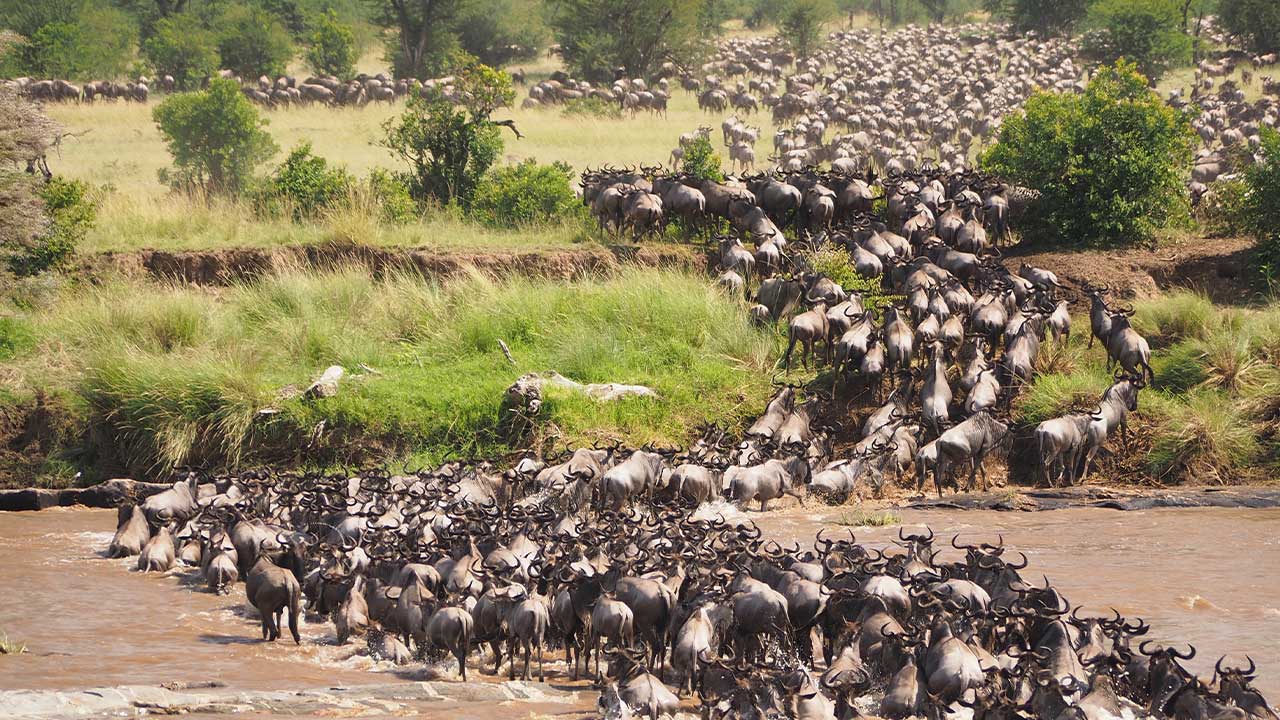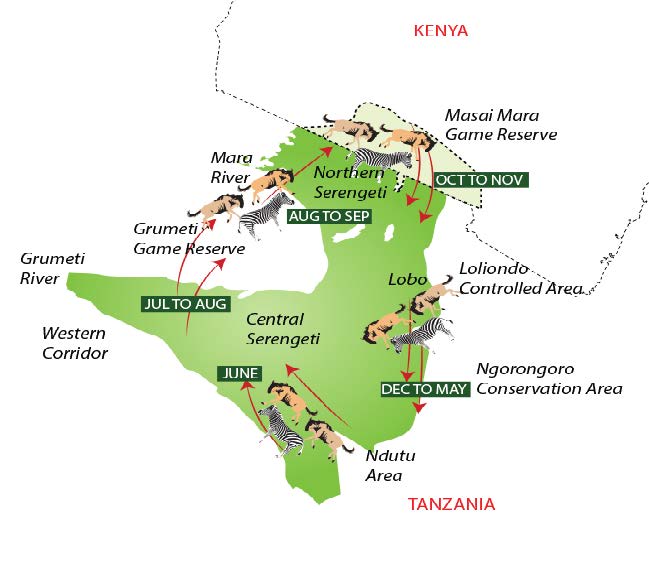
The Animals Migration, also known as The Great Migration, is one of nature’s most spectacular displays. Each year, millions of wildebeests and zebras embark on a journey through the Serengeti-Masai Mara ecosystem in search of food and water.
During the dry season (typically from June to October), the wildlife moves north from the Serengeti National Park in Tanzania to Kenya’s Masai Mara National Reserve. The Wildebeests are closely followed by predators such as lions, hyenas, and cheetahs, making for dramatic scenes on the savannah. As climate patterns change and resources shift, so too does the migration route, making each year unique and offering a new experience for safari-goers.
The herd moves throughout the year, as different parts of Serengeti and Masai Mara become favorable to the herds of wildebeest. Here is how the thousands of animals move around the Serengeti National Park and the Masai Mara National Reserve.
Below we’ve shared vital information on the monthly Serengeti Wildebeest Migration patterns to discover what the wildebeest migration is and when is the best time to travel.
In January and February, the wildebeest migrate to the southern plains of the Serengeti National Park to search for rain-ripened grass. The calving season also takes place during this time of the year, with half a million calves being born within a short span of weeks. The Month of March sees the migratory herd move towards the western corridor, between the Grumeti River and Masai Mara National Reserve. The Wildebeest must cross the crocodile-infested Grumeti River in order to reach new grasslands.
These months see the migration movement in the northern Serengeti, where they will spend the dry season of the year. The Grumeti River is still the herd source of water as the Serengeti and the surrounding area become dry. By the end of June, thousands of the wildebeest, zebras, and antelopes get ready for the Mara river crossings, which is one of the hardest tests (harder than the Grumeti Crossing).
July marks the wildlife crossing into the Masai Mara National Reserve in Kenya. The Wildebeests must brave the crocodile-filled River Mara to reach fresh grazing land, leading to dramatic scenes of survival and predators taking advantage of the weakened prey. Crossing the Mara River see the migration at its peak, making July and early August the perfect time to see the herds while on the move.
August sees the herd spread out across the Masai Mara, with more animals continuing to cross the Mara River from the northern Serengeti. Wildebeests and zebras also face the threat of lions, hyenas, and cheetahs hunting them as they grazed on the Masai Mara’s grasslands.
In September and October, the wildlife begins to move back towards the south of the Serengeti as the short rains begin. The grazers and their predators follow the rain-ripened grass, leading to tense river crossings once again as they move back in the northern part of Serengeti toward the southern part.

November and December see the wildebeest migration back in the southern Serengeti, where they will spend Christmas before starting their journey all over again in January.
The southern plains of the Serengeti are very fertile but they need rains to ripen the grass for a massive population of grazers.
The “short” and light rains fall in November and December (sometimes as early as October). This draws the migration rapidly south from Kenya’s Masai Mara down the eastern side of Tanzania’s Serengeti into these sweet short-grass plains.
The wildebeest and other ungulates settle in the southern plains between about January and April – usually the “easiest” time to see the migration in Tanzania. In April and May the “long” or heavy rains set in. The depleted southern plains are less attractive than the long grass plains up in the western corridor and the migration has started moving north (westerly) again.
Large river crossings on the Grumeti and Mara Rivers occur as the migration heads back into Kenya’s Maasai Mara – the season dries out and fresh grazing and water can be found in the far north. The Mara is usually at its best in August, September and October. The small maps below give a general idea on the movement of the migration, see a more detailed map of the Serengeti ecosystem plus explanations on how the migration really works!
Discover the real wild side of Africa on an adventure safari, choose an exciting tour that will ensure you have the holiday of a lifetime. Plan your exciting Tanzania Safari Tours with us and feel how adventure and expertise bring you satisfaction. High Peaks Expedition Ltd, is the best safari tour company in Africa specializing in African Safari Planing, Mountain Trekking and Beach Holidays tours.
Arusha – Tanzania
reservations {at} highpeaks-expeditions.com